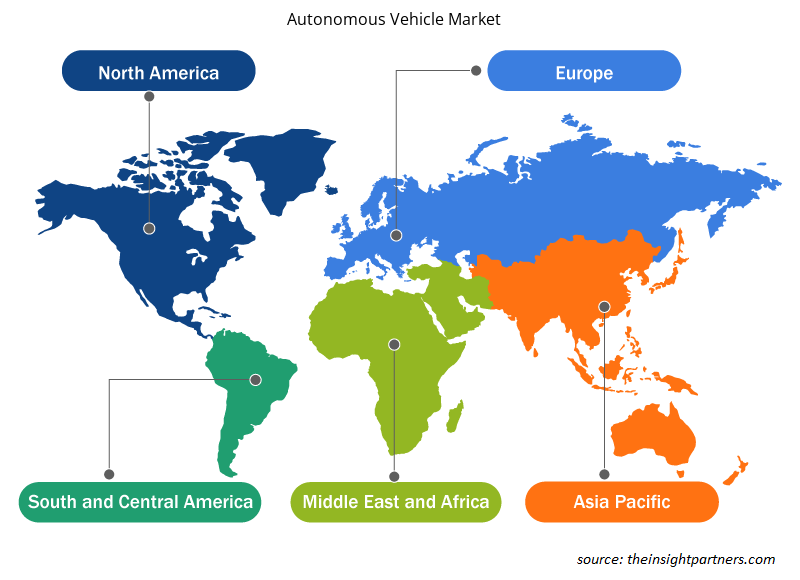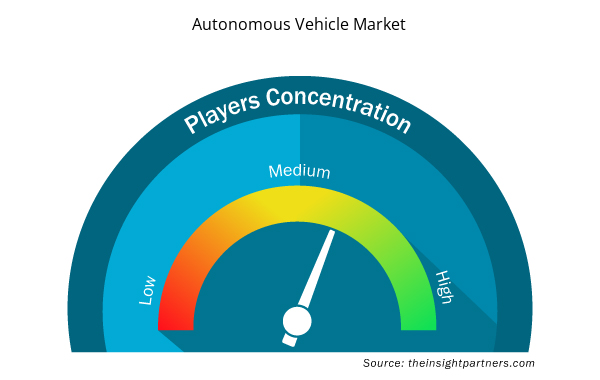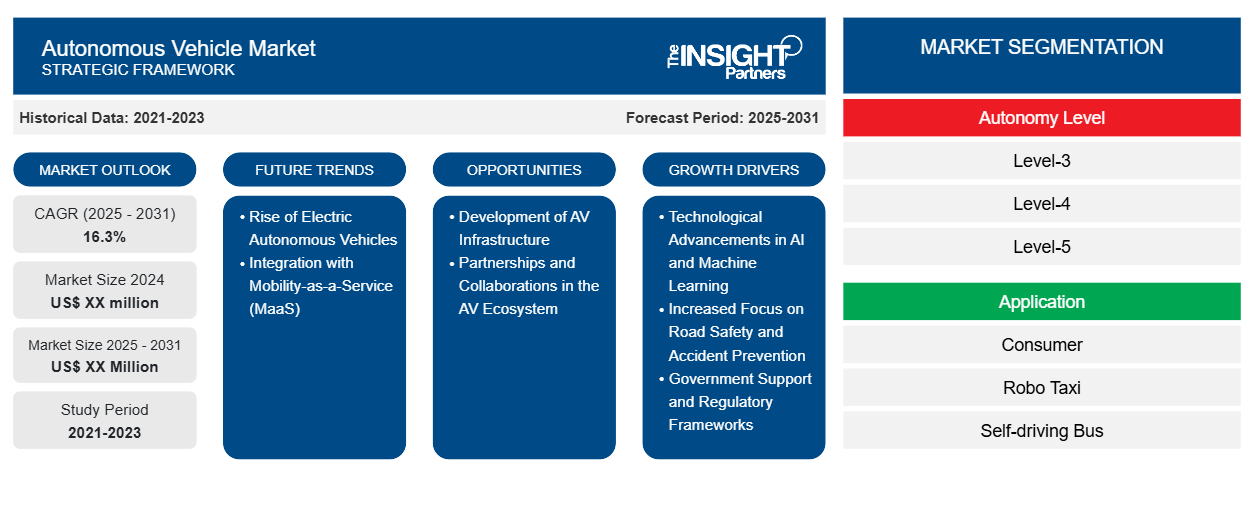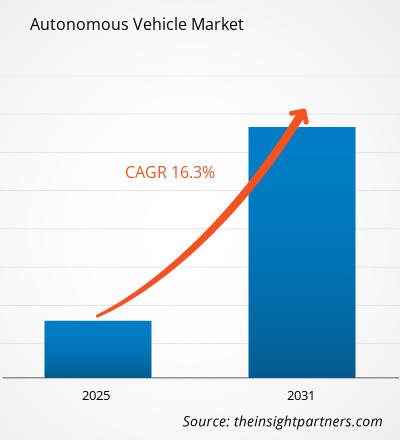自動運転車市場は、2023年から2031年にかけて16.3%のCAGRで成長し、市場規模は2023年のXX百万米ドルから2031年にはXX百万米ドルに拡大すると予想されています。
レポートは、自律レベル(レベル3、レベル4、レベル5)、アプリケーション(消費者、ロボタクシー、自動運転バス、ライドヘイル、ライドシェア)別にセグメント化されています。グローバル分析は、地域レベルと主要国でさらに細分化されています。レポートは、上記の分析とセグメントに対して米ドルでの価値を提供します。
報告書の目的
The Insight Partners によるレポート「自律走行車市場」は、現在の状況と将来の成長、主な推進要因、課題、機会を説明することを目的としています。これにより、次のようなさまざまなビジネス関係者に洞察が提供されます。
- テクノロジープロバイダー/メーカー: 進化する市場の動向を理解し、潜在的な成長機会を把握することで、情報に基づいた戦略的意思決定が可能になります。
- 投資家: 市場の成長率、市場の財務予測、バリュー チェーン全体に存在する機会に関する包括的な傾向分析を実施します。
- 規制機関: 市場の濫用を最小限に抑え、投資家の信用と信頼を維持し、市場の完全性と安定性を維持することを目的として、市場における政策と警察活動を規制します。
自動運転車市場のセグメンテーション
自律レベル
- レベル3
- レベル4
- レベル5
応用
- 消費者
- ロボタクシー
- 自動運転バス
- ライドヘイル
- ライドシェア
要件に合わせてレポートをカスタマイズする
このレポートの一部、国レベルの分析、Excelデータパックなど、あらゆるレポートを無料でカスタマイズできます。また、スタートアップや大学向けのお得なオファーや割引もご利用いただけます。
- このレポートの主要な市場動向を入手してください。この無料サンプルには、市場動向から見積もりや予測に至るまでのデータ分析が含まれます。
自動運転車市場の成長要因
- AI と機械学習の技術的進歩: AI と機械学習技術の継続的な進歩が、自動運転車 (AV) 市場を牽引しています。これらの進歩により、AV はセンサーからのデータをより適切に処理し、リアルタイムで意思決定を行い、安全性を強化できます。AI により、車両は環境をより正確に解釈できるようになり、ナビゲーション、衝突回避、交通管理が向上します。これらの技術が進化するにつれて、自動運転車の信頼性が高まり、消費者の信頼と受容が高まり、市場の成長が加速します。
- 道路の安全性と事故防止への注目度の高まり: 自動運転車は、交通事故の大半の原因となっている人為的ミスを減らすことができます。センサー、カメラ、高度なアルゴリズムを活用することで、AV は危険を予測し、人間のドライバーよりも迅速に対応できます。事故を大幅に減らし、命を救うというこの約束は、規制当局と消費者の両方の注目を集めています。政府と保険会社は、道路の安全性を向上させるために自動運転車技術をますますサポートしており、それが市場の成長を促進しています。
- 政府の支援と規制の枠組み: 世界中の政府は、将来の交通システムを形成するために、自動運転車技術に多額の投資を行っています。AV の開発とテストを奨励するために、政策、助成金、インセンティブが導入されています。さらに、規制機関は、自動運転車の安全性、サイバーセキュリティ、倫理基準を保証する枠組みの確立に積極的に取り組んでいます。この政府の支援と明確な規制ガイドラインにより、市場の信頼が高まり、自動運転車の道路への導入が加速します。
自動運転車市場の将来動向
- 電気自動運転車の台頭: 電気自動車 (EV) と自動運転車の技術の融合は新たなトレンドです。クリーン エネルギーで駆動する EV は、持続可能性と環境に優しい輸送の推進と一致しています。自動車メーカーが EV 用の自動運転システムを開発するにつれて、電気自動運転車の需要が高まっています。このトレンドは、環境政策、環境に優しい輸送手段に対する消費者の好み、EV のコスト効率の向上によって促進されています。今後数年間で、電気 AV への移行により、市場が大幅に拡大すると予想されます。
- モビリティ・アズ・ア・サービス (MaaS) との統合: 自動運転車市場を形成するもう 1 つのトレンドは、AV とモビリティ・アズ・ア・サービス (MaaS) プラットフォームの統合の増加です。消費者は、共有のオンデマンド交通モデルをますます好むようになり、自動車の所有を減らし、配車サービス、シャトル サービス、ラスト マイルの接続に AV を利用しています。MaaS プラットフォームは、自動運転車、バス、自転車などの交通手段を 1 つのシームレスなサービスに統合します。このトレンドは、都市交通エコシステムの中核部分としての自動運転車の拡大に貢献しています。
自動運転車の市場機会
- AV インフラストラクチャの開発: スマート シティとコネクテッド インフラストラクチャの世界的な推進により、自動運転車に大きなチャンスが生まれます。高度なセンサー、交通管理、車両対インフラストラクチャ (V2I) 通信を備えたスマート道路システムは、AV の安全性と効率性を高めることができます。これらの開発により、AV の導入に適した環境が整い、運用コストの削減、パフォーマンスの向上、事故の削減が可能になります。政府がインテリジェント インフラストラクチャに投資するにつれて、自動運転車市場は急成長を遂げる態勢が整っています。
- AV エコシステムにおけるパートナーシップとコラボレーション: 自動車メーカー、テクノロジー企業、研究機関間の戦略的パートナーシップは、AV イノベーションを加速させる貴重な機会となります。自動車およびテクノロジー分野の企業は、AI、センサー、データ分析、車両設計における互いの専門知識を活用できます。コラボレーションにより、より安全で信頼性が高く、手頃な価格の自律走行車の開発を推進できます。この共同アプローチは、イノベーションを促進し、商用展開を加速し、企業が AV 開発の経済的負担を分担するのに役立ちます。
自動運転車市場の地域別分析
予測期間を通じて自動運転車市場に影響を与える地域的な傾向と要因は、Insight Partners のアナリストによって徹底的に説明されています。このセクションでは、北米、ヨーロッパ、アジア太平洋、中東、アフリカ、南米、中米にわたる自動運転車市場のセグメントと地理についても説明します。

- 自動運転車市場の地域別データを入手
自動運転車市場レポートの範囲
| レポート属性 | 詳細 |
|---|---|
| 2023年の市場規模 | XX百万米ドル |
| 2031年までの市場規模 | XX百万米ドル |
| 世界のCAGR(2023年~2031年) | 16.3% |
| 履歴データ | 2021-2022 |
| 予測期間 | 2024-2031 |
| 対象セグメント | 自律レベル別
|
| 対象地域と国 | 北米
|
| 市場リーダーと主要企業プロフィール |
|
自動運転車市場のプレーヤー密度:ビジネスダイナミクスへの影響を理解する
自動運転車市場は、消費者の嗜好の変化、技術の進歩、製品の利点に対する認識の高まりなどの要因により、エンドユーザーの需要が高まり、急速に成長しています。需要が高まるにつれて、企業は提供を拡大し、消費者のニーズを満たすために革新し、新たなトレンドを活用し、市場の成長をさらに促進しています。
市場プレーヤー密度とは、特定の市場または業界内で活動している企業または会社の分布を指します。これは、特定の市場スペースに、その市場規模または総市場価値に対してどれだけの競合相手 (市場プレーヤー) が存在するかを示します。
自動運転車市場で事業を展開している主要企業は次のとおりです。
- BMW AG
- ダイムラーAG
- フォードモーターカンパニー
- ゼネラルモーターズ
- グループSA
免責事項:上記の企業は、特定の順序でランク付けされていません。

- 自動運転車市場のトップキープレーヤーの概要を入手
主なセールスポイント
- 包括的なカバレッジ: レポートでは、自律走行車市場の製品、サービス、タイプ、エンドユーザーの分析を包括的にカバーし、全体的な展望を提供します。
- 専門家による分析: レポートは、業界の専門家とアナリストの深い理解に基づいてまとめられています。
- 最新情報: このレポートは、最新の情報とデータの傾向を網羅しているため、ビジネスの関連性を保証します。
- カスタマイズ オプション: このレポートは、特定のクライアント要件に対応し、ビジネス戦略に適切に適合するようにカスタマイズできます。
したがって、自動運転車市場に関する調査レポートは、業界のシナリオと成長の見通しを解読し理解する道の先導役となる可能性があります。いくつかの正当な懸念があるかもしれませんが、このレポートの全体的な利点は欠点を上回る傾向があります。
- 過去2年間の分析、基準年、CAGRによる予測(7年間)
- PEST分析とSWOT分析
- 市場規模価値/数量 - 世界、地域、国
- 業界と競争環境
- Excel データセット



Report Coverage
Revenue forecast, Company Analysis, Industry landscape, Growth factors, and Trends

Segment Covered
This text is related
to segments covered.

Regional Scope
North America, Europe, Asia Pacific, Middle East & Africa, South & Central America

Country Scope
This text is related
to country scope.
よくある質問
Some of the customization options available based on the request are an additional 3-5 company profiles and country-specific analysis of 3-5 countries of your choice. Customizations are to be requested/discussed before making final order confirmation, as our team would review the same and check the feasibility.
The report can be delivered in PDF/PPT format; we can also share excel dataset based on the request.
The leading players operating in the Autonomous Vehicle Market include BMW AG, Daimler AG, Ford Motor Company, General Motors, Groupe SA, Renault Nissan Mitsubishi alliance, Tesla Inc, Toyota Motor Corporation, Volkswagen Group
The Autonomous Vehicle Market is estimated to witness a CAGR of 16.3% from 2023 to 2031
Shift Towards Enhanced Safety Features is the key future trend of the Autonomous Vehicle Market
The major factors driving the Autonomous Vehicle Market are:Technological Advancements#Increasing Consumer Demand for Connectivity
Trends and growth analysis reports related to Automotive and Transportation : READ MORE..
The List of Companies
1. BMW AG
2. Daimler AG
3. Ford Motor Company
4. General Motors
5. Groupe SA
6. Renault-Nissan-Mitsubishi alliance
7. Tesla Inc.
8. Toyota Motor Corporation
9. Volkswagen Group
10. Volvo-Autoliv-Ericsson-Zenuity alliance
The Insight Partners performs research in 4 major stages: Data Collection & Secondary Research, Primary Research, Data Analysis and Data Triangulation & Final Review.
- Data Collection and Secondary Research:
As a market research and consulting firm operating from a decade, we have published and advised several client across the globe. First step for any study will start with an assessment of currently available data and insights from existing reports. Further, historical and current market information is collected from Investor Presentations, Annual Reports, SEC Filings, etc., and other information related to company’s performance and market positioning are gathered from Paid Databases (Factiva, Hoovers, and Reuters) and various other publications available in public domain.
Several associations trade associates, technical forums, institutes, societies and organization are accessed to gain technical as well as market related insights through their publications such as research papers, blogs and press releases related to the studies are referred to get cues about the market. Further, white papers, journals, magazines, and other news articles published in last 3 years are scrutinized and analyzed to understand the current market trends.
- Primary Research:
The primarily interview analysis comprise of data obtained from industry participants interview and answers to survey questions gathered by in-house primary team.
For primary research, interviews are conducted with industry experts/CEOs/Marketing Managers/VPs/Subject Matter Experts from both demand and supply side to get a 360-degree view of the market. The primary team conducts several interviews based on the complexity of the markets to understand the various market trends and dynamics which makes research more credible and precise.
A typical research interview fulfils the following functions:
- Provides first-hand information on the market size, market trends, growth trends, competitive landscape, and outlook
- Validates and strengthens in-house secondary research findings
- Develops the analysis team’s expertise and market understanding
Primary research involves email interactions and telephone interviews for each market, category, segment, and sub-segment across geographies. The participants who typically take part in such a process include, but are not limited to:
- Industry participants: VPs, business development managers, market intelligence managers and national sales managers
- Outside experts: Valuation experts, research analysts and key opinion leaders specializing in the electronics and semiconductor industry.
Below is the breakup of our primary respondents by company, designation, and region:

Once we receive the confirmation from primary research sources or primary respondents, we finalize the base year market estimation and forecast the data as per the macroeconomic and microeconomic factors assessed during data collection.
- Data Analysis:
Once data is validated through both secondary as well as primary respondents, we finalize the market estimations by hypothesis formulation and factor analysis at regional and country level.
- Macro-Economic Factor Analysis:
We analyse macroeconomic indicators such the gross domestic product (GDP), increase in the demand for goods and services across industries, technological advancement, regional economic growth, governmental policies, the influence of COVID-19, PEST analysis, and other aspects. This analysis aids in setting benchmarks for various nations/regions and approximating market splits. Additionally, the general trend of the aforementioned components aid in determining the market's development possibilities.
- Country Level Data:
Various factors that are especially aligned to the country are taken into account to determine the market size for a certain area and country, including the presence of vendors, such as headquarters and offices, the country's GDP, demand patterns, and industry growth. To comprehend the market dynamics for the nation, a number of growth variables, inhibitors, application areas, and current market trends are researched. The aforementioned elements aid in determining the country's overall market's growth potential.
- Company Profile:
The “Table of Contents” is formulated by listing and analyzing more than 25 - 30 companies operating in the market ecosystem across geographies. However, we profile only 10 companies as a standard practice in our syndicate reports. These 10 companies comprise leading, emerging, and regional players. Nonetheless, our analysis is not restricted to the 10 listed companies, we also analyze other companies present in the market to develop a holistic view and understand the prevailing trends. The “Company Profiles” section in the report covers key facts, business description, products & services, financial information, SWOT analysis, and key developments. The financial information presented is extracted from the annual reports and official documents of the publicly listed companies. Upon collecting the information for the sections of respective companies, we verify them via various primary sources and then compile the data in respective company profiles. The company level information helps us in deriving the base number as well as in forecasting the market size.
- Developing Base Number:
Aggregation of sales statistics (2020-2022) and macro-economic factor, and other secondary and primary research insights are utilized to arrive at base number and related market shares for 2022. The data gaps are identified in this step and relevant market data is analyzed, collected from paid primary interviews or databases. On finalizing the base year market size, forecasts are developed on the basis of macro-economic, industry and market growth factors and company level analysis.
- Data Triangulation and Final Review:
The market findings and base year market size calculations are validated from supply as well as demand side. Demand side validations are based on macro-economic factor analysis and benchmarks for respective regions and countries. In case of supply side validations, revenues of major companies are estimated (in case not available) based on industry benchmark, approximate number of employees, product portfolio, and primary interviews revenues are gathered. Further revenue from target product/service segment is assessed to avoid overshooting of market statistics. In case of heavy deviations between supply and demand side values, all thes steps are repeated to achieve synchronization.
We follow an iterative model, wherein we share our research findings with Subject Matter Experts (SME’s) and Key Opinion Leaders (KOLs) until consensus view of the market is not formulated – this model negates any drastic deviation in the opinions of experts. Only validated and universally acceptable research findings are quoted in our reports.
We have important check points that we use to validate our research findings – which we call – data triangulation, where we validate the information, we generate from secondary sources with primary interviews and then we re-validate with our internal data bases and Subject matter experts. This comprehensive model enables us to deliver high quality, reliable data in shortest possible time.


 このレポートの無料サンプルを入手する
このレポートの無料サンプルを入手する